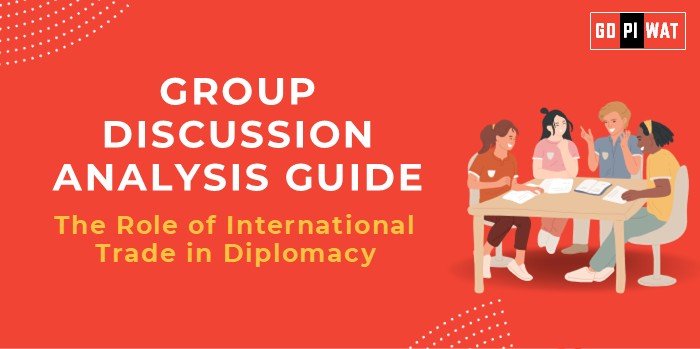📋 Group Discussion Analysis Guide
🌍 Introduction to the Topic
📖 Context: International trade is a cornerstone of globalization, fostering interdependence among nations. With a value surpassing $28 trillion in 2022, it shapes economic policies and influences diplomatic ties globally.
📜 Background: Dating back to the Silk Road, trade has long been a tool for diplomatic engagements. Modern trade agreements, such as the EU-US Trade and Technology Council, demonstrate its role in aligning strategic interests.
📊 Quick Facts and Key Statistics
- 💵 Global Trade Volume (2022): $28 trillion – Highlights the extensive economic interconnectivity.
- 📈 Number of Active FTAs (2023): Over 350 globally – Reflects increasing bilateral and multilateral collaborations.
- 🇨🇳🤝🇺🇸 China-USA Trade (2022): $690.6 billion – Despite tensions, underscores economic interdependence.
- 🌍 BRICS Trade Growth (2023): 10% YoY – Signifies emerging economies’ role in trade-driven diplomacy.
🌟 Stakeholders and Their Roles
- 🏛️ Governments: Formulate policies and negotiate trade agreements.
- 🌐 International Bodies: WTO and IMF mediate disputes and ensure fair trade practices.
- 🏢 Corporations: Drive cross-border investments and supply chains.
- 👥 Civil Society: Advocate for ethical trade practices and labor standards.
🏆 Achievements and Challenges
🌟 Achievements:
- 📈 Economic Growth: Countries like Vietnam have seen GDP boosts through strategic trade agreements like the CPTPP.
- 🕊️ Conflict Resolution: Trade partnerships like ASEAN minimize regional disputes.
- 💻 Technology Exchange: US-China trade accelerates innovation through mutual R&D efforts.
⚠️ Challenges:
- 🌍 Geopolitical Tensions: E.g., US-China trade war impacts global supply chains.
- ⚖️ Unequal Gains: Developing nations often face trade imbalances.
- 🌱 Environmental Concerns: Rising emissions from shipping and production.
🌍 Global Comparisons:
- 🇪🇺 EU’s Trade Policy: Balances internal economic growth and external diplomatic ties.
- 🇨🇳 China’s Belt and Road Initiative: Aims to expand influence via trade-led diplomacy.
📚 Case Studies:
- 🇮🇳🤝🇦🇪 India-UAE CEPA (2022): Boosted bilateral trade by 30% within a year.
- 🇺🇸🤝🇨🇦🤝🇲🇽 NAFTA to USMCA: Revamped agreements enhance North American cooperation.
✨ Structured Arguments for Discussion
- 💬 Supporting Stance: “International trade fosters diplomatic ties by aligning mutual interests, as seen in EU-ASEAN relations.”
- ⚖️ Opposing Stance: “Over-reliance on trade can lead to diplomatic conflicts, evidenced by the EU-Russia energy crisis.”
- 🔄 Balanced Perspective: “While trade strengthens alliances, it must be complemented by robust conflict-resolution mechanisms.”
🎯 Effective Discussion Approaches
📖 Opening Approaches:
- “Global trade accounts for over half of the world GDP. How does this influence diplomatic strategies?”
- “From the WTO to FTAs, trade agreements often serve as blueprints for peace and collaboration.”
🔄 Counter-Argument Handling:
- Acknowledge downsides like trade wars but emphasize solutions like fair-trade practices.
📈 Strategic Analysis of Strengths and Weaknesses
- 💪 Strengths: Promotes economic growth, encourages peace through interdependence.
- ⚠️ Weaknesses: Can exacerbate inequalities.
- 💡 Opportunities: Strengthening emerging markets via regional trade blocs.
- 🚨 Threats: Geopolitical risks like embargoes.
📚 Connecting with B-School Applications
- 🌟 Real-World Applications: Study trade’s impact on emerging markets and sustainable supply chains.
- 💬 Sample Interview Questions:
- “How does international trade contribute to global diplomacy?”
- “Discuss a recent trade agreement and its diplomatic implications.”
- 📖 Insights for Students:
- Analyze FTAs in projects.
- Explore trade-led economic policies during internships.


